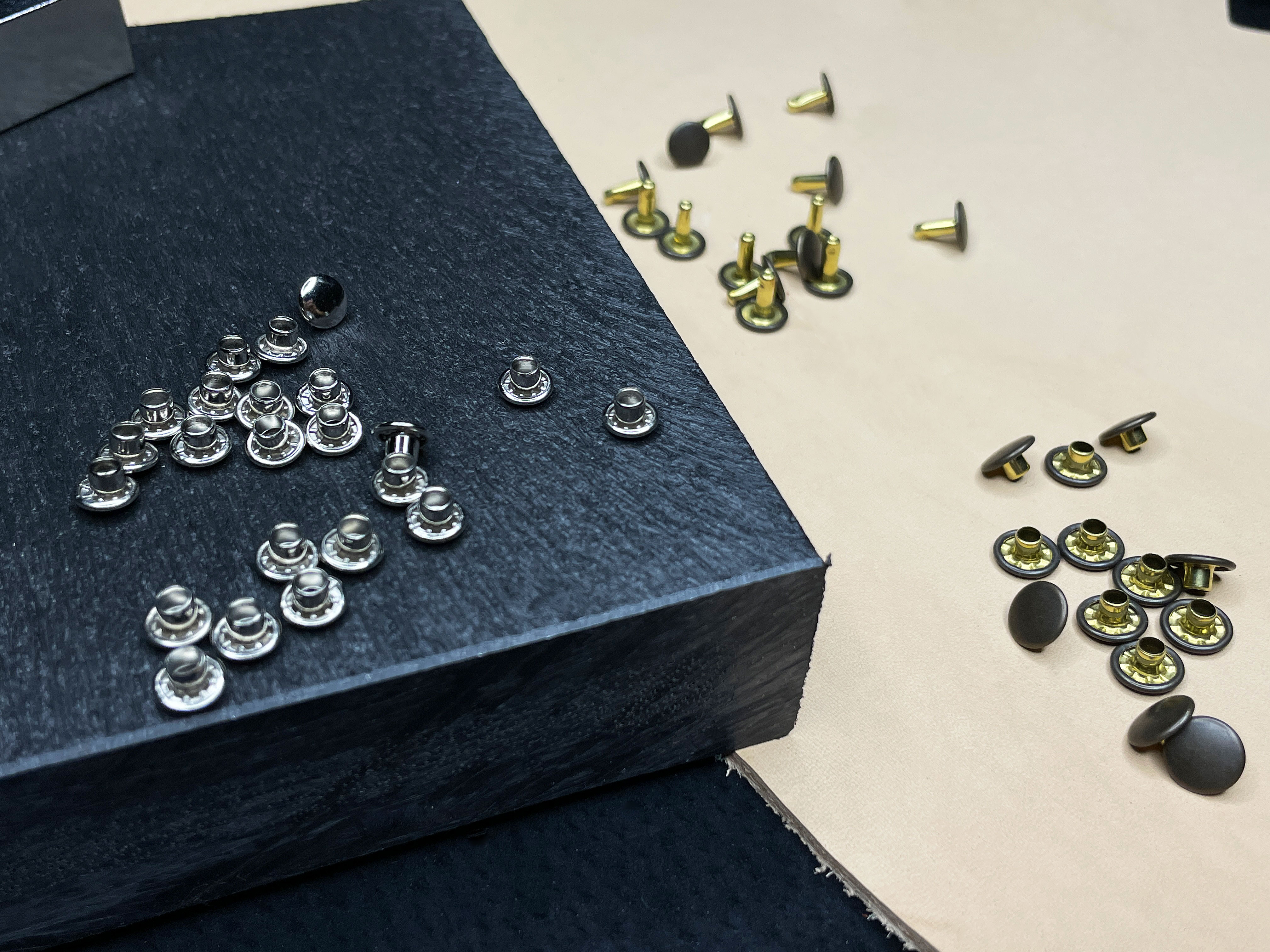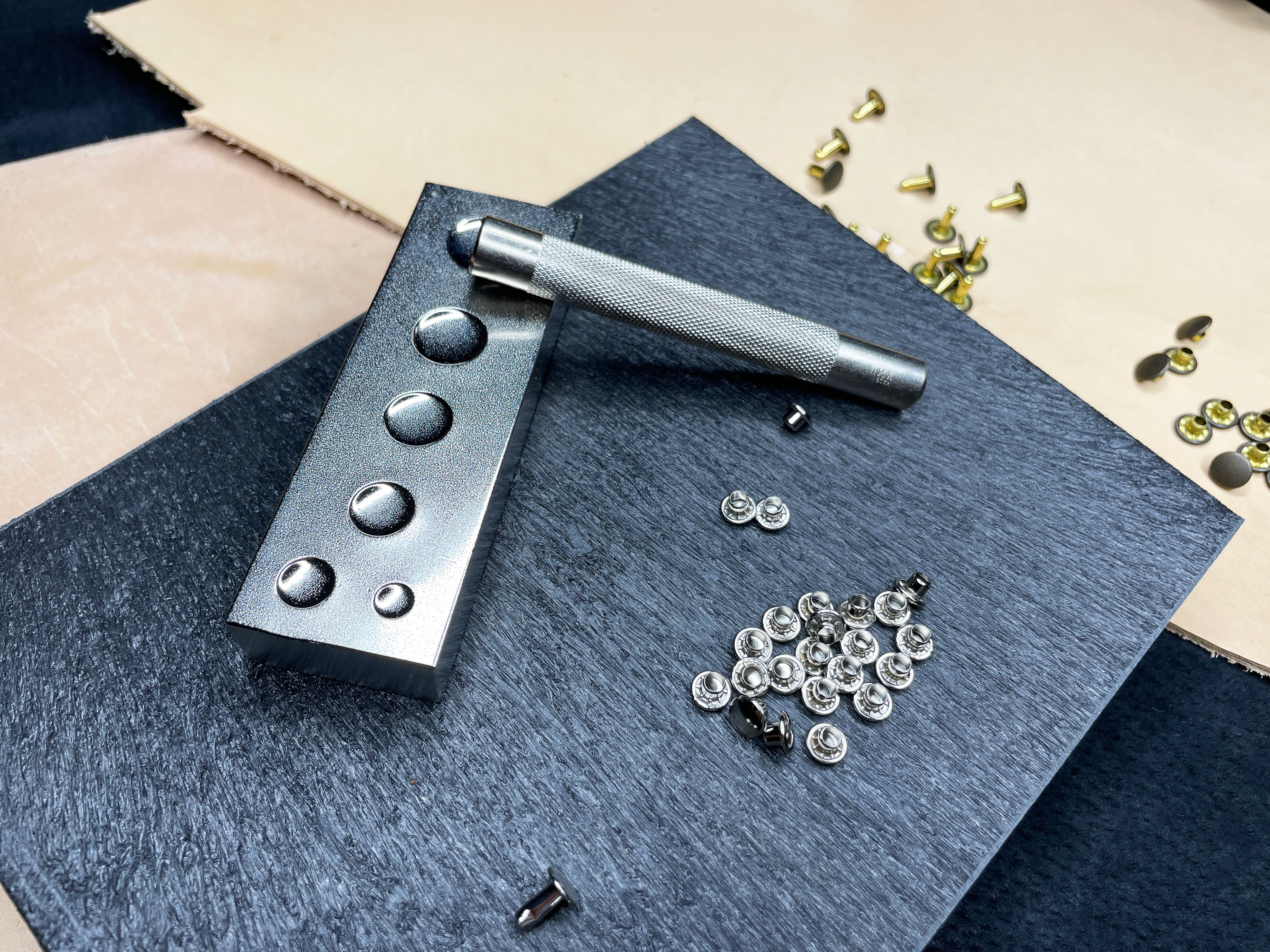Rivets are essential accessories in the leather world and leather goods. When working with leather, whether you are a passionate or a professional, rivets will always make an appearance in your leather projects. Whether it is to tie two leather pieces together, or to refine your leather belt, the question remains the same :
- How do I apply a rivet to leather?
Which tool should I use to set my double cap rivet?
In theory :
Whether it is a double cap* or single cap rivet, several solutions are available to you depending on your creation frequency and your budget :
- For occasional use, it is best to use a rivet setter, or a hand press, to set all types of accessories.
- However, if you are used to creating on a more frequent basis, it is better to use a mechanical bench press, which avoids repeated efforts. In terms of precision, it can't be beaten, but it's a much bigger expense
*"Double cap" means that both parts of the rivet have a solid head, whereas "single cap" models have only one, leaving a hollow on the second head of the rivet.
In order to set your rivet in one go, you can use an anvil, which will facilitate the setting by avoiding rebound and will protect both parts of the rivet, in the case of a double cap.
Specially designed for rivet, snaps, and press studs, the steel anvil makes your work easier. It has 6 concave recesses of different diameters, allowing you to place the rounded head of your rivet without damaging the surface.
What is the purpose of choosing the size of my rivet for working with leather?
After choosing the colour and finish that suits you : (old brass, chrome, plated, nickel-plated, gold-plated...), it is important to choose the dimensions of your rivets according to the leather thickness:
- T.0 and T.1 for a leather thickness between 1.0 and 2.5 mm
- T.2 for a leather thickness between 2.0 et 4.0 mm
- T.3 for a leather thickness between 2.0 et 5.0 mm
- T.4 for a leather thickness between 3.0 et 5.0 mm
- T.5 for a leather thickness between 3.0 et 6.0 mm
It is this crucial choice that will ensure that your leather bag, leather belt, or even leather bracelets are strong and durable.
Having learned the tips and discussed the various pitfalls to avoid, it is now time to move on to the application.
How to set a rivet manually? To be followed step by step :
In practice :
Here are the steps for setting a rivet manually using a steel anvil and a rivet setter : (follow the steps or watch the video below)
Step 1 :
Use a marker or a pen to locate the place where you are going to pierce your leather. It is this initial reflex carried out beforehand that will guarantee you a professional result at the end.
Step 2 :
Once the location is marked, drill with a punch or pliers.
Step 3 :
Next, hold the two parts of your creation together (hole against hole) to slide in your rivet pin (part 1).
Step 4 :
Now snap the rivet cap (part 2) so that it attaches to the rivet tip (part 1), closing the leather pieces with it.
(Note that the leather must always have been drilled before installation, as rivets are not self-piercing tools).
Tip: before performing the manoeuvre on your final piece, don't hesitate to practice on a piece of leather or on leather scraps. Give short, sharp blows to avoid deforming your rivet.
Step 5 :
After assembling by hand, place the round head of the rivet in the correct hole in your anvil and then tap the handle of your rivet setter several times with a round maul. This will provide sufficient pressure to set the fastener permanently.
Tip: When striking your rivet setter, it is best to use a wooden mallet or a round polymer maul to avoid damaging your tools.
Final Step :
Congratulations, you have just crimped your accessories through your leather. All you have to do now is test their strength by pulling on your straps for example.
Note that if the rivet fastener pops out, it means that the crimping was not done properly, or that the thickness of your leather is too thick for the size of your rivets.
What does it look like on video ?
It is often said that a picture is worth a thousand words :
We invite you to read our other articles on our BLOG.
You will find tips, tricks and technical elements that will allow you to become a real expert in the subject.



